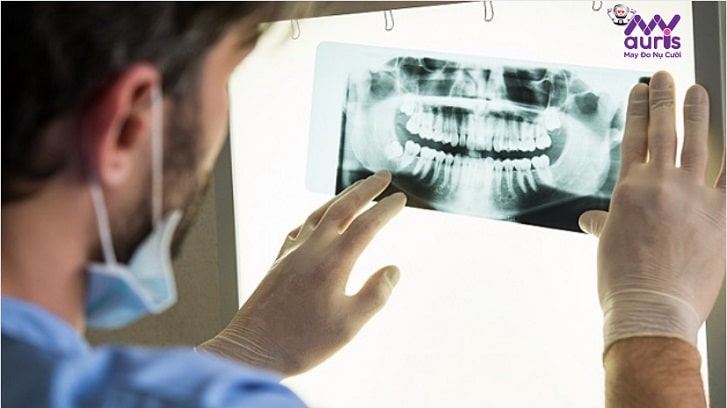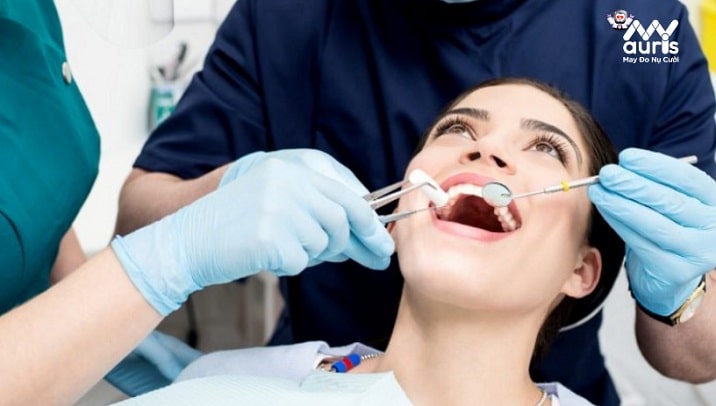Dental implants are the optimal method of restoring lost teeth. However, this technique still has some complications, the most typical of which is inflammation of the implant. This is a quite serious complication and requires attention to oral health after implantation. Therefore, this article has been compiled from the specialized knowledge of My Auris dentistry. Thanks to that, we can help many customers find a definitive treatment after implant placement.
How to deal with inflammation of an implant?
Inflammation of an implant or peri-implantitis is a problem. In case of infection, it destroys the supporting bone in the tissues surrounding the implant.
The cause of this infection is not cleaning the food stuck in between the teeth, at which time bacteria will accumulate and penetrate the implant post to form implant pockets. Over time, these pockets will cause inflammation and affect the bone layer that supports the implant. From there, it causes bone destruction and causes the implant to be rejected.
Furthermore, because the adhesion of the Implant surface to the surrounding tissue will be lower than that of natural teeth, the rate of bone destruction will be faster than normal periodontitis.
The rate may lead to inflammation after Implant placement will account for about 5% to 8%.

Causes of inflammation around the abutment Implant
Inflamed implant is one of the risks that no one wants after performing an implant. The cause of this situation is due to the subjectivity of the customer as well as the doctor’s incorrect technical procedure. These include the following reasons:
Proper oral hygiene care
Oral hygiene and care will be affected even after implant placement. Furthermore, peri-implant inflammation can occur when patients frequently do not brush their teeth or brush their teeth incorrectly. Therefore, this will be a habit that is harmful to oral health. From there, it gives them the opportunity to invade the gums, leading to inflammation over time.
Using stimulants after implant placement
After implant placement, customers need to limit the use of stimulantssuch as alcohol and tobacco for at least the first 4 weeks. In case the customer does not care about this issue, peri-implant inflammation or even abutment rejection may occur.
Collision during strong trauma
After implant placement, customers need to be careful not to exercise vigorously to avoid collision to the newly implanted tooth area. When the implant is first completed, the jawbone is still weak. Therefore, if there is a significant impact such as brushing your teeth too hard, the position where the implant has been inserted will be damaged. From there, it leads to the implant post becoming loose and infection occurring, which will endanger oral health.

How to know if you have inflammation around the root of your implant no?
Infected implant placement is one of the serious complications compared to peri-implant mucositis. At this time, the gums will be red and inflamed and there will be no strong adhesion to the jawbone. With this condition, diagnosis and treatment will be based on factors such as:
- Change in color of gums from red to dark black. Furthermore, there will be bleeding of the gums;
- Check the depth of the pocket around the implant;
- Formation of pus pockets in teeth;
- In addition, the doctor will often order X-rays to check the height of the bone around the implant. At the same time, evaluate bone loss on X-ray based on the level of bone difference between time points. In case the bone loss level exceeds the physiological bone loss level by about 1.5mm in the first year.
What is the treatment direction after implant inflammation?
Treatment of peri-implantitis will depend on each specific case. However, they will be performed based on standard rules such as controlling infection, reducing the depth of the pocket around the implant and regenerating the new tooth bone socket in case of bone loss around the implant.
Therefore, to optimize treatment methods and help customers recover quickly. When diagnosing peri-implantitis, doctors will often apply two treatment methods: surgical and non-surgical treatment. Below are the specifically applied treatment methods:
Non-surgical treatment method
The first principle of this treatment method is to remove plaque and bacteria to avoid bacteria from growing around soft tissue. In some cases, prolonged peri-implantitis may be related to periodontal disease, at which point the patient needs to completely treat both of these diseases.
Treatment methods used to remove bacteria on the implant surface such as;
- Remove tartar and clean plaque;
- Systemic antibiotic use for the purpose of fighting infections with commonly used compounds such as Metronidazole and Spiramycin in combination.
- Topical antiseptic applied to the face is soaked in a mixture of chlorhexidine and saline. This can help disinfect the inflamed area and reduce infection when the implant pocket is greater than 5 mm deep.
- Laser treatment: Helps stimulate wound healing while reducing swelling and discomfort.

Surgical treatment method for peri-implantitis
The doctor will separate and scrape the implant pocket, and clean the implant surface with a titanium brush. Furthermore, drills and lasers that can be combined with connective tissue grafting are often prescribed to treat peri-implant inflammation.
For cases where peri-implantitis resorbs more than ¼ of the length or the implant tooth is loose at level 3. Or the implant tooth is loose horizontally over 0.5 mm and the level of shake is 4 or in some cases the entire length is loose. and vertical. At this time, the doctor will prescribe the removal of the implant, clean the teeth and wait for the gums to heal before placing another implant.
Preventive measures after an inflamed implant
Peri-implantitis often occurs during recovery after implant placement, which will complicate the treatment process. Therefore, preventing inflammation plays a key role in the success or failure of implant placement.
Therefore, below are some ways to prevent peri-implant inflammation that the doctors at My Auris dentistry will show you:
- Brush your teeth every day, at least twice a day before going to bed and after waking up;
- Do not use toothpicks with sharp objects, but use dental floss to clean remaining plaque on teeth;
- Use an interdental brush or water flosser to clean difficult-to-clean areas;;
- Check general dental health at least every 6 months, thereby removing plaque as well as early detection of peri-implant inflammation for timely treatment.
The above are related contents about inflamed implants that will help you have safe solutions if this situation occurs. At the same time, for safe and effective dental implant restoration results, you should choose a reputable and quality dentist. At My Auris dentistry, it is a gathering place for medical talent and doctors, while meeting procedures that are performed properly and according to standards with advanced equipment.
Kim Dung





